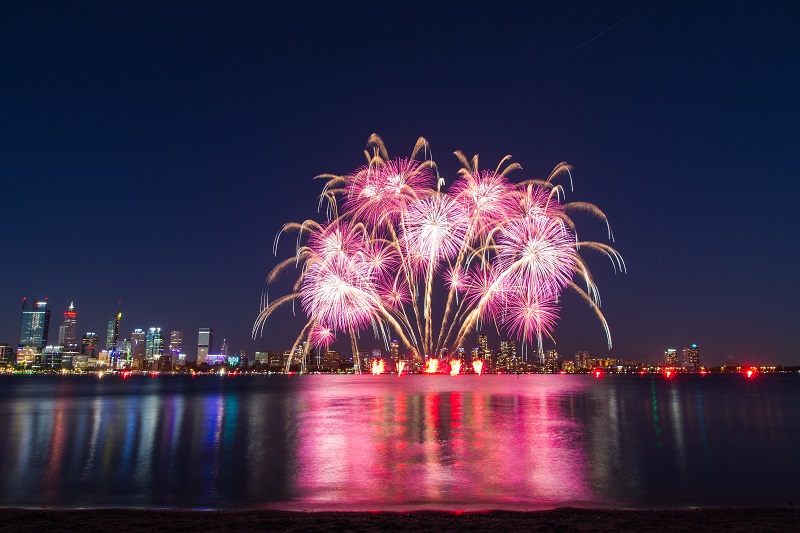


New Year’s Eve is fast approaching, which means it’s a great time to get some colourful fireworks photos! Here’s our quick tutorial on how to shoot fireworks photography.
To ensure you are ready to capture amazing fireworks photos, key things you will need to consider are the location, your gear, and what camera settings you’ll need.
Location
Fireworks shows tend to get busy so it helps to get in position—with a great view of the area where the fireworks will be—well before the fireworks start. It’s generally easy to see where the fireworks will be launched from, so keep an eye out for this.
As for your exact location - you want to be close to the fireworks but not too close so that they end up above you. So take a look around the area, look for somewhere where you’ll be comfortable and think about which elements you’d like (or not like) in your frame, e.g. buildings, trees or a bridge.
Another important thing to bear in mind is the direction of the wind. Fireworks create a lot of smoke so make sure you’re not downwind of where they will be in the sky. This will help ensure you get a nice clean shot.
Gear
Camera and wide angle lens
Of course you will need a camera (a DSLR or mirrorless camera will do the trick) so you can attach a wide angle lens. (Alternatively, a large-sensor compact or bridge camera with a wide angle lens and the ability to control your settings will work too.)
Best lens for fireworks photography
A wide angle lens with a focal range of 16-35mm (full-frame equivalent) would be great as a starting point.
If you’re a little further away from the action a mid-range zoom lens such as a 24-105mm equivalent could be handy too.
Find out more about lenses in Lenses 101: An Essential Guide.




Tripod
A sturdy tripod is essential for fireworks photography, which requires long exposures (i.e. when you keep your camera’s shutter open for more time than usual). A tripod will keep your camera steady throughout the exposure, thereby minimising blur in your images.
Shutter release
A cable release or remote release is also really handy if you have one, as this will minimise camera shake from your pressing the shutter button. Alternatively you can set up a 2 second timer delay on your camera, which will do a similar job to a shutter release.
Memory cards
To help your camera function at its fastest, be sure to have a fast (95MB/s+) memory card or two.
Don’t forget to empty your memory card in advance – there’s nothing worse than having to delete images to clear space while on location, and potentially missing a shot!
Batteries
Finally, make sure your camera batteries are charged in advance so you can snap away all evening without any worries.
Composition
Once you’ve found an ideal vantage point and unpacked your camera and tripod, it’s time to think about your composition.
When you’re ready to compose your shots, hold up your camera and check out your surroundings while looking through your viewfinder or display monitor.
For an interesting composition consider framing the fireworks between buildings or trees, or above or beside a bridge or monument. While images of fireworks bursts against a plain black sky are beautiful and colourful, it can be more striking and distinctive to frame the fireworks between buildings on the city skyline.
Once you find a composition you like, set up your tripod. This will be easier than trying to decide on an ideal composition while your camera is already on your chosen tripod.
Tip: Consider your composition in advance so you’re prepared when the fireworks displays start, and not fumbling around with your lens or tripod and potentially missing out on shots!


Settings
Once you’re all set up with your camera and tripod, it’s time to get your settings ready!
Quick Tips for Fireworks Photography Settings
-
Shutter priority (TV / S) mode
-
Slow shutter speed, e.g. 2 seconds (2”)
-
Low ISO setting, e.g. ISO 100
-
Manually lock focus on your lens
To start with, set your camera to TV / S (shutter priority) mode and choose a slow shutter speed – start at perhaps 2 seconds (2”) and go from there. Be sure to choose a low ISO setting (e.g. ISO 100) and long exposure noise reduction (if your camera has that function) to help minimise image noise.
Once your camera is set, it’s time to lock your focus. With your lens in autofocus mode, focus on a point within the frame, such as a building. Once your lens has focused on this point, flick the focus switch on the side of your lens from auto to manual mode, without changing the focus of your lens. Doing this will keep the lens ‘locked’ on your autofocus point, so when the fireworks start your lens won’t be wasting time hunting for a point to focus on. Don’t worry if you bump your lens mid-shoot; just repeat the process to ‘lock’ the focus point and you’ll be set to go again.




Summary: Top Tips for Photographing Fireworks
-
Get a good spot early!
-
Use a tripod
-
Use a cable release or timer
-
Set a low ISO value, e.g. ISO 100
-
Use slow shutter speeds, e.g. 2 seconds (2”)
-
Autofocus then manually ‘lock’ focus on your lens
Those are our top tips for fireworks photography! Don’t be afraid to experiment with your shutter speed and composition. Have fun and be sure to email or share your fireworks images with us.
Want more tips on how to photograph fireworks?
Chat to one of our staff photographers
or message us in the comments below!
